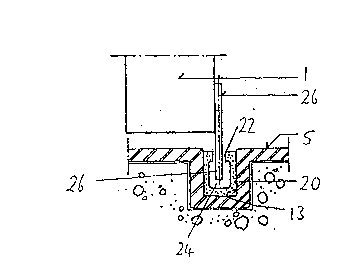Une partie des informations de ce site Web a été fournie par des sources externes. Le gouvernement du Canada n'assume aucune responsabilité concernant la précision, l'actualité ou la fiabilité des informations fournies par les sources externes. Les utilisateurs qui désirent employer cette information devraient consulter directement la source des informations. Le contenu fourni par les sources externes n'est pas assujetti aux exigences sur les langues officielles, la protection des renseignements personnels et l'accessibilité.
L'apparition de différences dans le texte et l'image des Revendications et de l'Abrégé dépend du moment auquel le document est publié. Les textes des Revendications et de l'Abrégé sont affichés :
| (12) Demande de brevet: | (11) CA 2078016 |
|---|---|
| (54) Titre français: | RAIL DE GUIDAGE |
| (54) Titre anglais: | GUIDE TRACK |
| Statut: | Réputée abandonnée et au-delà du délai pour le rétablissement - en attente de la réponse à l’avis de communication rejetée |
| (51) Classification internationale des brevets (CIB): |
|
|---|---|
| (72) Inventeurs : |
|
| (73) Titulaires : |
|
| (71) Demandeurs : |
|
| (74) Agent: | BULL, HOUSSER & TUPPER LLP |
| (74) Co-agent: | |
| (45) Délivré: | |
| (22) Date de dépôt: | 1992-09-11 |
| (41) Mise à la disponibilité du public: | 1993-03-14 |
| Requête d'examen: | 1994-06-29 |
| Licence disponible: | S.O. |
| Cédé au domaine public: | S.O. |
| (25) Langue des documents déposés: | Anglais |
| Traité de coopération en matière de brevets (PCT): | Non |
|---|
| (30) Données de priorité de la demande: | ||||||
|---|---|---|---|---|---|---|
|
ABSTRACT
A GUIDE TRACK
A guide track (20) for receiving a guide bracket (26)
of a sliding door (1), the guide track (20) including a
longitudinal opening (22) having a width adapted to
accommodate and guide a guide bracket (26), during use, and
an internal channel (24) within the track (20) communicating
with the longitudinal opening (22) along the length of the
track (20), wherein the width of the internal channel (24)
is greater than the width of the longitudinal opening (22).
This arrangement enables debris falling into the guide track
to be swept along the internal channel (24) without blocking
the track (20) and causing malfunction of the sliding doors.
Note : Les revendications sont présentées dans la langue officielle dans laquelle elles ont été soumises.
Note : Les descriptions sont présentées dans la langue officielle dans laquelle elles ont été soumises.

2024-08-01 : Dans le cadre de la transition vers les Brevets de nouvelle génération (BNG), la base de données sur les brevets canadiens (BDBC) contient désormais un Historique d'événement plus détaillé, qui reproduit le Journal des événements de notre nouvelle solution interne.
Veuillez noter que les événements débutant par « Inactive : » se réfèrent à des événements qui ne sont plus utilisés dans notre nouvelle solution interne.
Pour une meilleure compréhension de l'état de la demande ou brevet qui figure sur cette page, la rubrique Mise en garde , et les descriptions de Brevet , Historique d'événement , Taxes périodiques et Historique des paiements devraient être consultées.
| Description | Date |
|---|---|
| Demande non rétablie avant l'échéance | 1998-09-11 |
| Le délai pour l'annulation est expiré | 1998-09-11 |
| Inactive : Renseign. sur l'état - Complets dès date d'ent. journ. | 1998-01-21 |
| Inactive : Abandon. - Aucune rép dem par.30(2) Règles | 1997-11-03 |
| Réputée abandonnée - omission de répondre à un avis sur les taxes pour le maintien en état | 1997-09-11 |
| Inactive : Dem. de l'examinateur par.30(2) Règles | 1997-05-02 |
| Exigences pour une requête d'examen - jugée conforme | 1994-06-29 |
| Toutes les exigences pour l'examen - jugée conforme | 1994-06-29 |
| Demande publiée (accessible au public) | 1993-03-14 |
| Date d'abandonnement | Raison | Date de rétablissement |
|---|---|---|
| 1997-09-11 |
Les titulaires actuels et antérieures au dossier sont affichés en ordre alphabétique.
| Titulaires actuels au dossier |
|---|
| CROWN YORK INDUSTRIAL LIMITED |
| Titulaires antérieures au dossier |
|---|
| EMILY WAI YING CHAN |